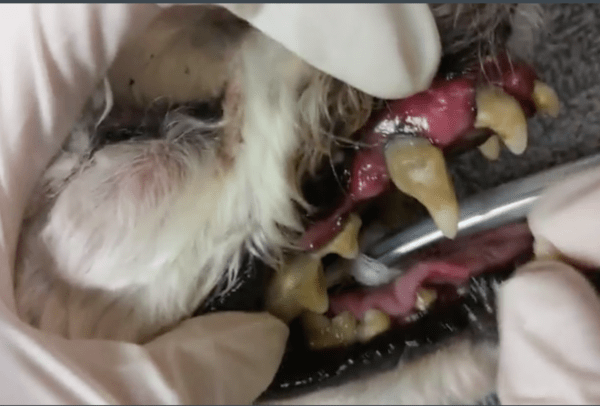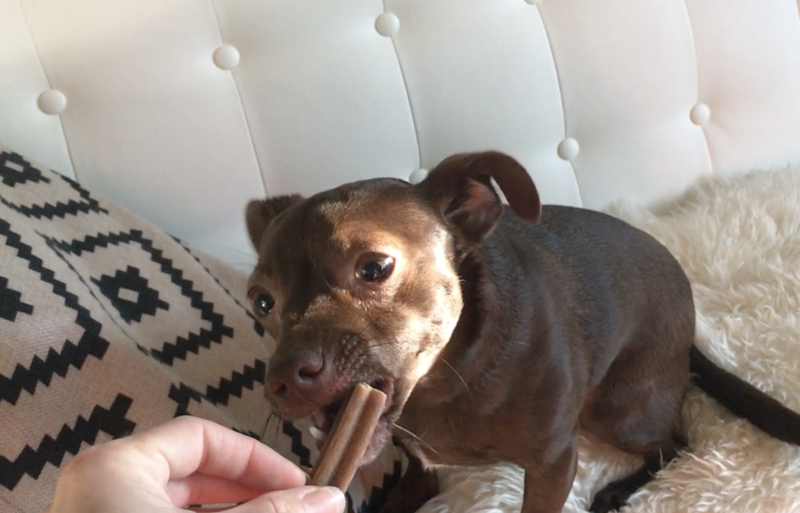Canine dental treats have become very popular. The reason? Concerned pup parents want to keep their dog’s teeth clean and healthy. Dogs love them! Dental chews claim to supplement dog’s dental care by cleaning teeth, freshening breath, and helping to reduce plaque buildup and tartar. And you pay for that promise: some dental treats are more than $2 each. If you are feeding your dog one a day that’s $730 a year in just chews.

But do these dental treats actually do what they claim to or are they just a high-priced treat?
We went to Dr. Stephen Riback, veterinary dentist at The Animal Medical Center in NYC.
When asked if dental treats are worth investing in, Dr. Riback said “I do think these products are ‘worth it’ but not as a sole means of keeping the teeth clean. I think they are a good adjunctive therapy to daily brushing and annual dental cleaning.”
“Brushing your dog’s teeth every day is the best way to achieve good dental health – along with an annual professional cleaning under anesthesia with dental x-rays,” he adds.
Let’s talk about brushing real quick…
Your pup may absolutely hate his toothbrush (like most dogs), but he sure isn’t immune to the dangers of plaque and tartar. As Dr. Riback notes (and you’ve probably heard the same from your vet), brushing your dog’s teeth on a daily basis is the gold standard when it comes to canine healthcare.
Still, dental care is a big concern for pet parents, even the responsible ones who brush their dog’s teeth daily. Did you know that 4 out of 5 dogs over the age of 3 suffer from canine dental disease? The American Veterinary Dental Society reports “more than 80 percent of dogs develop periodontal disease by three years of age.” It starts with a yellowish-brown coating on your dog’s teeth, and it eventually leads to sensitive gums, loss of appetite, and broken teeth. Extreme tartar buildup can even cause other health issues when bacteria from the mouth enters the bloodstream.

As with people, the only real way to get that nasty stuff off your dog’s teeth is to scrape it away. Your dentist does this every time you go in for a cleaning, by scaling your teeth. Veterinarians also do this during your pup’s recommended yearly dental cleaning.
In between dental visits we brush, floss and many of us chew gum. Chewing gum gently scrubs teeth clean of plaque and food debris, helping to prevent tartar.
Gum is not safe for dogs, however, but the same chewing action can be achieved through dental chews. The mechanical motion involved in chewing dental treats effectively reduces plaque by scraping gunk and bacteria off teeth. According to Web MD Pets, regularly chewing on dental treats can reduce plaque by 70%.
So how do you choose the right dental treat?
It’s only natural that pet owners desire more help in keeping their pup’s teeth clean. Unsurprisingly, the advent of dental treats was wholeheartedly embraced by loving dog owners. Dog dental treats are the easiest way to brighten your pup’s smile. It seems like the obvious way to help your dog’s teeth. Dogs love them, too.

The trick is, however, choosing a product that actually works. Not all dental treats are the same! Ideally, you want your pup to be chewing on the treat for as long as possible. If the treat is too small or too easy to break apart, they won’t benefit from the abrasive cleaning. Though a treat may look to be too big for your dog, the seemingly too large size is actually a plus.
While the chewing motion is the most important part of this equation, what your dog is chewing on also matters. Treats made with the enzymes lysozyme, lactoferrin, and lactoperoxidase are especially good for your dog’s teeth. These enzymes work together to reduce the plaque that will eventually harden into tartar.
Avoid dental treats with unnecessary ingredients like dyes and artificial flavorings. You also don’t want to sacrifice a trim waistline for healthy teeth. Dental chews should be low calorie and low fat.
What we recommend…
We’ve tried many dental chew products with our own pups and came to the realization that, as picky pawrents, we needed to create our own! That’s why we worked with veterinarians to craft Project Paws® Grain Free Triple Enzyme Dental Sticks.
They check all the boxes when it comes to choosing a dental treat that’s both healthy and effective. The veterinarian formulated recipe promotes dental health on three levels: fighting plaque, controlling tartar, and freshening your dog’s breath. The sticks are low in calories, and you can treat your pup everyday without worrying about overfeeding.
They feature those 3 critical enzymes, lysozyme, lactoferrin and lactoperoxidase, and also include curcumin, a flavonoid that has been found to help support periodontal health.
They’re also the only dental treat on the market that supports the health of shelter dogs waiting to be adopted. Each bag provides 7 healthy meals to shelter dogs! Who knew so much good could come out of one dental treat?
These statements have not been evaluated by the Food and Drug Administration. This product is not intended to diagnose, treat, cure, or prevent any disease. The information on this website is not intended to replace a one-on-one relationship with a qualified healthcare professional.

 Toledo, United States.
Toledo, United States.
